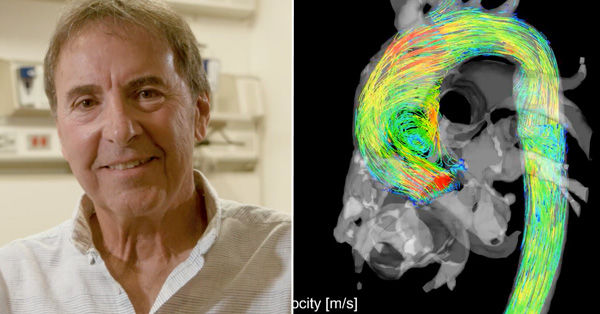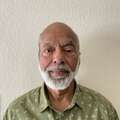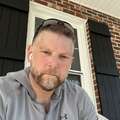Technology Update: How Did 4D-MRI Help John Time Bicuspid Valve & Aneurysm Surgery?
Written By: Adam Pick, Patient Advocate, Author & Website Founder
Page last updated: November 7, 2023
Timing heart valve surgery can be tricky for cardiologists, for surgeons and, ultimately, for patients. For this reason, doctors and medical device companies are working together to develop next-generation technologies to determine the right time to operate or to continue “watchful waiting”.
I wanted to learn more about this topic, so I met with John Pascarella from Frankfort, Illinois. John was unexpectedly diagnosed with severe aortic stenosis, a bicuspid aortic valve and an aortic aneurysm during a Medicare physical. Interestingly, John was not rushed into surgery. Instead, Dr. Chris Malaisrie, a leading cardiac surgeon at Northwestern Medicine, used Four Dimensional Magnetic Resonance Imaging (4D-MRI) to watch John closely until surgery was needed. This is John’s story…
Many thanks to John for sharing his story with me. I’m glad to hear that John is doing so well after his minimally invasive aortic valve replacement and aneurysm repair. I would also like to extend a special thanks to Dr. Chris Malaisrie and the entire medical team at the Bicuspid Aortic Valve Program at Northwestern Medicine for their innovative approach to diagnosing, tracking and treating bicuspid aortic valves.
- See Dr. Malaisrie’s Interactive Surgeon Profile.
- Discover Northwestern Medicine’s Heart Valve Microsite.
Keep on tickin!
Adam
P.S. For the hearing impaired members of our community, I posted a written transcript of my interviews with John and Dr. Malaisrie below.
John Pascarella: My name’s John Pascarella. I live in Frankfurt, Illinois. My father, he was 58 years old when he had coronary bypass surgery, and on my mom’s side, a couple of my uncle’s on her side had heart attacks. It’s definitely in my family, so I really didn’t go to the doctor until I was 65 and went for my Medicare physical. He asked me if I had any problems. I told him I had a slight heart murmur. He says, “John,” he says, “You have a severe aortic stenosis, and it’s something you’re going to have to go see a cardiologist. This is something we’ve got to take seriously. “What I’m going to want you to do,” he says, “I’m going to send you to a surgeon,” he says, “Dr. Chris Malaisrie at Northwestern.” My first reaction was, well, if I go see the surgeon, he’s going to want to do surgery. He says, “No, not necessarily. He’s going to tell you what it is, you know.”

Dr. Chris Malaisrie: Bicuspid aortic valve is one of the most common congenital heart problems. We estimate that approximately 1 to 2% of the general population will have a bicuspid aortic valve. Mr. Pascarella was born with an abnormal heart valve. He eventually developed aortic stenosis, which is calcification of the aortic valve, restricting the blood flow out of the heart. In addition, he also had an aortic aneurysm, which is common in patients with bicuspid aortic valve.
John Pascarella: I didn’t feel like I was ready at that time because I had no symptoms.
Dr. Chris Malaisrie: Many patients with bicuspid aortic valve don’t need surgery right away, so we follow our patients with 4D MRI. The MRI flow with the advanced technology we have is able to demonstrate wall shear stress and abnormal blood flow. We can follow these patients and follow their abnormal blood flow within the aorta. The pattern of blood flow does make a difference in terms of progression, and when is the appropriate time to recommend surgery. When he developed symptoms, he came to see us and we had recommended a minimum invasive approach to fix both his aortic valve and his aortic aneurysm.
John Pascarella: I had minimally invasive surgery, so I had a small incision. It was only about four inches, maybe at the most. I had my aorta repaired and aortic valve replaced. The recovery was great.
Dr. Chris Malaisrie: Mr. Pascarella did great after his minimally invasive aortic valve replacement and aneurysm repair. We know that minimally invasive cardiac surgery can reduce the trauma associated with open-heart surgery and enhance recovery for our patients. We’re glad to see him get back to work very quickly with great results.
John Pascarella: Everybody was great, from the nurses, to technicians, to the – everyone. Dr. Malaisrie and his team, they’re awesome.
Dr. Chris Malaisrie: Our BAV program has been in existence now for five years, and we have brought together a multi-disciplinary approach for the treatment and management of our patients with a bicuspid aortic valve. We’d like to finally thank all of our patients who’ve contributed data to our bicuspid aortic valve program in order to make lives for future patients with bicuspid valves better.
John Pascarella: I can run. I can lift weights. I can do whatever I want. Before that, I couldn’t. I had all the restrictions on me leading up to the surgery. Overall, it was a good experience. It wasn’t something I was actually looking forward to, but now that it is completed, I mean, it gives you a new outlook on life.













